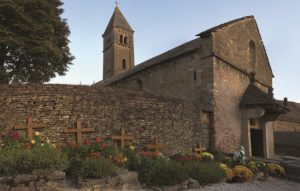During a Taizé service at the United Methodist Church in Wellfleet, Tony Pastucci, a retired Catholic priest, serves as the cantor, his sonorous voice weaving through the simple, chant-like songs led by Sieglinde Rogers, the Methodist pastor. Ken Roscoe, who served as the minister of Wellfleet’s First Congregational Church from 1977 to 2008, drives the music forward on the piano.
This interdenominational trio has been leading Taizé services on the last Friday of each month throughout the summer, and they’re planning one for Sept. 23. Their boundary crossing is “what Taizé is all about,” says Pastucci.
The service, influenced by monastic forms of prayer, meditation, and silence, is rooted in the concept of unity, meant to be welcoming to people from both Catholic and Protestant traditions. Founded in 1944 in the village of Taizé in Burgundy, France, the tradition’s simple, ecumenical style of worship has spread around the world.

Taizé is both place and practice. Roger Schütz, who came to be known as Brother Roger, was founder of the practice. He grew up in Switzerland where he was involved in the student Christian movement. Drawn to France because his mother was from there, he first went to Taizé with his sister in 1940 to hide refugees fleeing the Nazi occupation. The town was close to German-occupied territory.
What he later established was “a place where prayer is dedicated to reconciliation and peace,” Pastucci says. “His rationale was, ‘we can’t have a group based on the idea of reconciliation and harmony if we’re not harmonious ourselves.’ ”
Rogers, who has always incorporated Taizé in her work as a pastor, says she likes the way it welcomes people from different traditions. And in Wellfleet, she says, a typical Taizé service often includes people who are unaffiliated or not religious. “We focus on what we have in common rather than our differences,” says Pastucci, who describes the prayers and songs as similar to early Christian forms of worship.
“An important part of the service is a period of silence and meditation,” says Pastucci. “It can go on for five or ten minutes. You’ve been doing these prayers to God and now you need to be quiet and let God talk to you.”
That silence can be uncomfortable for some, Rogers says. In contemporary life, she points out, “everything is so instantaneous. Sometimes we lose ourselves. It takes time and intention to be still.”
Even in silence, Rogers notes, “there is internal noise.” One’s breath, for instance. That’s not necessarily a distraction, Rogers says — you might consider it a way to get “in rhythm with the breath of life.”
Erika Pfammatter was at the Taizé service in August. It was her first. She was struck by a line of Scripture Rogers read: “Be still and know that I am God.” Rogers kept re-reading the same line, leaving off one word each time, ending with “Be.”
“I could just be, just be quiet,” says Pfammatter. “And have a moment of deep peace in my day.”
Pfammatter, a pianist and harpist, found the musical encounter different from what she is accustomed to as either an audience member or a performer. “I wasn’t taking in the music like a meal I bought or something I’m trying to master,” she says. “Reading the music didn’t matter. I let the people around me teach me the song. I either sang along or didn’t. It was almost like swimming. I could drift in or drift out.”
“Short and repetitive” is the way Pastucci describes the songs particular to Taizé. Their simplicity allows easy entry points for people of different musical abilities and speakers of different languages. It keeps going, says Pastucci, in repeated ostinato phrases, a technique used in many religious traditions. “The repetition leads you into a deeper contemplation,” he says, “into a deep mystery.”
Yet Rogers says that, unlike some meditative rituals, such as saying the rosary, “Taizé is communal. Every voice matters.” For her, it’s about finding unity across denominations — “in our humanity.”
Taizé, says Pastucci, is not something that takes you out of your church. Instead, he says, “You bring it back to your own spiritual community.”
